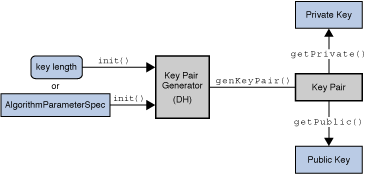Java Generate Public Key And Private Key
In order to be able to create a digital signature, you need a private key. (Its corresponding public key will be needed in order to verify the authenticity of the signature.)
In some cases the key pair (private key and corresponding public key) are already available in files. In that case the program can import and use the private key for signing, as shown in Weaknesses and Alternatives.
In other cases the program needs to generate the key pair. A key pair is generated by using the KeyPairGenerator class.
The most popular Public Key Algorithms are RSA, Diffie-Hellman, ElGamal, DSS. Generate a Public-Private Key Pair. There are several ways to generate a Public-Private Key Pair depending on your platform. In this example, we will create a pair using Java. The Cryptographic Algorithm we will use in this example is RSA. To sign an assembly with a strong name, you must have a public/private key pair. This public and private cryptographic key pair is used during compilation to create a strong-named assembly. You can create a key pair using the Strong Name tool (Sn.exe). Key pair files usually have an.snk extension. $ begingroup$ I don't watch videos, but IF they're talking about TLS-formerly-SSL (and protocols layered on it like HTTPS) it is now fairly common to use elliptic Diffie-Hellman with 'ephemeral' keypairs (generated during the handshake, used once and destroyed) for the actual key agreement, and authenticate it with elliptic DSA using a long-term key in a certificate.
Nov 29, 2016 These keys are known as Public and Private Key Pair, and as the name implies the private key must remain private while the public key can be distributed. The most popular Public Key Algorithms are RSA, Diffie-Hellman, ElGamal, DSS. Using the AS Java Key Storage. Creating a Key Pair and Public-Key Certificate and Signing It Send feedback. Here you will find information on how to generate a new private key and certificate (referred to as keypair) and then sign the certificate using an external Certification Authority (CA). Nov 10, 2011 How to Generate A Public/Private SSH Key Linux By Damien – Posted on Nov 10, 2011 Nov 18, 2011 in Linux If you are using SSH frequently to connect to a remote host, one of the way to secure the connection is to use a public/private SSH key so no password is transmitted over the network and it can prevent against brute force attack.
In this example you will generate a public/private key pair for the Digital Signature Algorithm (DSA). You will generate keys with a 1024-bit length.
Generating a key pair requires several steps:
Create a Key Pair Generator
The first step is to get a key-pair generator object for generating keys for the DSA signature algorithm.
As with all engine classes, the way to get a KeyPairGenerator object for a particular type of algorithm is to call the getInstance static factory method on the KeyPairGenerator class. This method has two forms, both of which hava a String algorithm first argument; one form also has a String provider second argument.
A caller may thus optionally specify the name of a provider, which will guarantee that the implementation of the algorithm requested is from the named provider. The sample code of this lesson always specifies the default SUN provider built into the JDK.
Put the following statement after the

Symmetric Key
line in the file created in the previous step, Prepare Initial Program Structure:
Initialize the Key Pair Generator

The next step is to initialize the key pair generator. All key pair generators share the concepts of a keysize and a source of randomness. The KeyPairGenerator class has an initialize method that takes these two types of arguments.
The keysize for a DSA key generator is the key length (in bits), which you will set to 1024.
Dec 08, 2015 Click on the start button on your windows XP after you have installed it. Right click on “My Computer” and then go to the “Properties” tab and click it. Check for the “Windows Activation” at the most bottom and click on “Change Product Key”. Windows xp pro sp3 key generator.
The source of randomness must be an instance of the SecureRandom class that provides a cryptographically strong random number generator (RNG). For more information about SecureRandom, see the SecureRandom API Specification and the Java Cryptography Architecture Reference Guide .
The following example requests an instance of SecureRandom that uses the SHA1PRNG algorithm, as provided by the built-in SUN provider. The example then passes this SecureRandom instance to the key-pair generator initialization method.
Some situations require strong random values, such as when creating high-value and long-lived secrets like RSA public and private keys. To help guide applications in selecting a suitable strong SecureRandom implementation, starting from JDK 8 Java distributions include a list of known strong SecureRandom implementations in the securerandom.strongAlgorithms property of the java.security.Security class. When you are creating such data, you should consider using SecureRandom.getInstanceStrong(), as it obtains an instance of the known strong algorithms.
Generate the Pair of Keys
Java Generate Public Key And Private Key Location
The final step is to generate the key pair and to store the keys in PrivateKey and PublicKey objects.